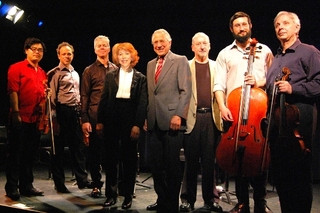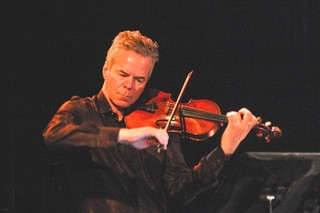|
Back
Tom Jefferson And The Frantic Fiddles New York
Symphony Space
04/13/2015 -
Cutting Edge Concerts: New Music Festival 2015:
Jeremy Harman: Paths Become Lines – Heal
Fung Chern Hwei: Ceili
Gregor Huebner/Monteverdi: Fantasy on “Lamento d’Arianna” (Premiere)
Gregor Huebner: Racing Mind
Kyle Gann: Hudson Spiral (Premiere)
Victoria Bond: Soul of a Nation (Premiere)
Frank Almond (Violin), Gerald Doyle (Narrator); Sirius Quartet: Fung Chern Hwei, Gregor Huebner (Violins), Ron Lawrence (Viola), Jeremy Harman (Cello); Victoria Bond (Conductor)

F. C. Hwei, G. Huebner, F. Almond, V. Bond, M. Lee, G. Doyle,
J. Harman, R. Lawrence (© Nick Levitin)
Tom Jefferson’s strings, part scratchy, part mellow:
A Cremona fiddle, and a Monti-Cello.
J.W. von Goethe (Freely translated)
Dr. Myles Lee, who wrote the libretto for Soul of a Nation used one word summing up last night’s concert. President Thomas Jefferson was a “polymath”. And the latest “Cutting Edge Concert” at Symphony Space was indeed a polymathisist’s delight, including five jazz improvisations, a strict canonic algorithm, an aria by Monteverdi, an ancient dance arranged by Archangelo Corelli, and yes, a musical portrait of America’s third president.
All of this with a single string quartet, actor and violin soloist.
Since last night celebrated Jefferson’s 272nd birthday, and since Victoria Bond was not only the composer-conductor of the piece, but the producer of Cutting Edge Concerts, one must give her primary honors. The previous chamber works I had heard from this very fecund writer have been very impressive indeed. But she tackled the complex subject with only (only!!??) the Sirius String Quartet and soloist Frank Almond and his gorgeous fiddle.
Both the title, Soul of a Nation and most of Dr. Lee’s writing fell mainly into that unfortunate trap of hagiography. Nowadays we know that Jefferson’s life is less that of Mount Rushmore granite than a Passion Play. What was torture to him we would call hypocrisy, his verbal idealism belied by his doubts and his actions. But he was still one of our great diplomats, a prescient President, and, with Thomas Paine, one of the most eloquent writers of the American Revolution.
Dr. Lee has already written words to musical portraits of Washington and F.D.R., and with Jefferson he had the opportunity to show not only the savant but the aggregations of a singular mind. Regrettably, his words consisted of well-known Jeffersoniania: the opening of the Declaration of Independence, Jefferson’s religious skepticism, and a quote on music and the freedom of the human spirit. Each section introduced by the phrase “And there he stood.” (Which could refer to Luis, the deli guy making my bagel and cream cheese.)
While these were read with appropriate earnestness by actor Gerald Doyle, the words were less impressive than Victoria Bond’s highly original music. Eschewing the kind of Copland Lincoln Portrait patriotic religiosity, she used one of the scores in Jefferson’s library, the Corelli arrangement of the ancient Portuguese La Folia. But instead of duplicating it, Ms. Bond incarnated it with combinations of the Sirius Quartet, with the rhythms of the original Folia, working it through the entire work. Nor did she attempt a musical equivalent of Jefferson’s words. While the music stopped at times for Ms. Doyle’s words, that seemed natural.

F. Almond (© Nick Levitin)
In a way, this was a kind of mini-concerto, with Frank Almond, one of the world’s most distinguished concertmasters presently with the Milwaukee Symphony Orchestra. His own 1750 Stradivarius came from the same Cremona forest as President Jefferson’s own three violins. But one doubts that Old Tom could play with the ravishing colors and soaring lines as Mr. Almond.
Ms. Bond conducted this assemblage with her usual aplomb. Yet so fascinating was her intricate accessible fantasia on La Folia that she could have dispensed with the verbiage, and rearranged the music to stand on its own. If she were the hundredth composer to play with La Folia, then she could still declare her independence from the others with her own inspiration.
This work followed a canon by Kyle Gann, who is admittedly obsessed with canons. It was intricate, tricky, will be a joy for theorists and went on with more theoretical than musical fascination.
The first half was devoted to the Sirius Quartet, which for over a decade has led in string quartet “avant-jazz and post-rock” (I quote from the program notes). Briefly, each player has the background of improvisation, and while each of their own five works was different, they exercised that background to the utmost.
This was not the pristine, cool European jazz so horribly displayed by L’Arpeggiata last week. The improvs had a bite, no matter what the genre. First violin Fung Chern Hwei’s Ceili, (the Gaelic word for a party) had what seemed like a Hebraic theme (though Ireland’s most famous Jew Leopold Bloom, didn’t drink), and the after-party desolation was pictured with some beautiful riffs by the performer. Cellist Jeremy Harmon, coming from Kansas City jazz and rock heritages, started Paths Become Lines with a stunning slow section developing into a jazzy bonanza. His Heal was another piece of scintillating colors and rhythms.
Gregor Huebner had what I felt were two of the most inventive works. His Racing Mind, based on an Afro-Cuban beat started with two of the musicians imitating drums, and the others improvising over the original dreamy theme. His Fantasy on (Claudio Monteverdi’s) “Lamento d’Arianna” had a similarity with Victoria Bond’s Folia fantasy. One barely recognized the original chromatic oh so far-seeing Monteverdi ode, yet the descending notes gradually took shape, albeit with its jazz improvisations. Ms. Bond let her music simply decorate the work, but Mr. Huebner finished his Fantasy with an abbreviated "straight” quote from the Monteverdi itself.
As for the concert itself, one might use the more prosaic but more appropriate word, “Original.” All seven works were singular, some worked better than others, but each piece was a tribute to the composer, and obviously a joy to the players.
Harry Rolnick
|